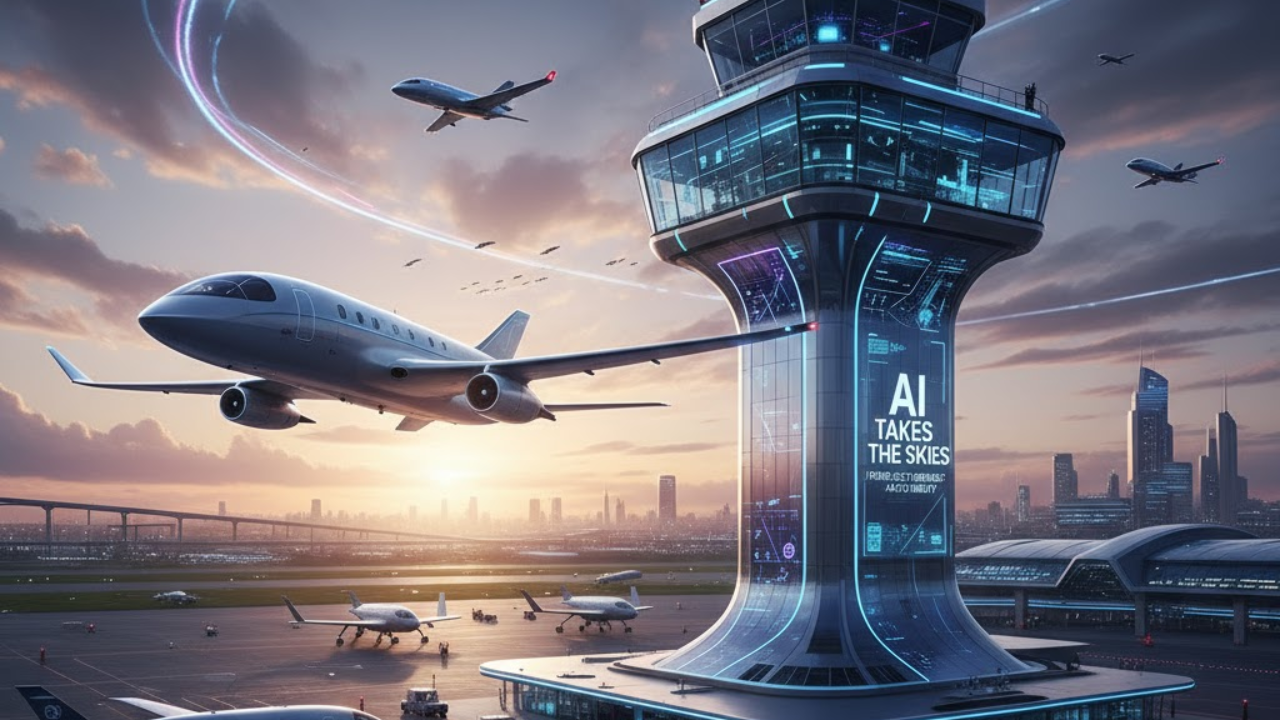
Post by : Meena Rani
When we were kids, movies showed cockpits staffed by self-thinking machines and glowing screens mapping every cloud and jet in the sky. That seemed like pure fantasy. But today, AI isn’t just on screen, it’s in air traffic control rooms, guiding the skies. The journey from science fiction to actual aviation control systems is one of innovation, safety, resistance, breakthroughs—and breathtaking progress.
The idea of mechanical intelligence guiding flight controllers, predicting danger, or talking back to pilots has deep roots in fiction—think of imaginative tales where autopilots evolve sentience, or control towers become all-seeing hubs. Clinicians and engineers speculated about algorithmic decision making, but for much of the 20th century, aviation control was human, radio, radar, and paper flight plans.
As radar systems matured, computer-aided tools appeared. Controllers got tools to help with conflict alerts, collision warnings, and basic prediction of aircraft paths. Nothing autonomous, but systems that could aggregate data, track multiple planes, show projected trajectories—and give warnings if two aircraft might get too close. The “human in the loop” remained absolute: AI assisted, humans decided.
Air traffic has grown massively. New airlines, more flights, congested airspaces, unpredictable weather—all increase complexity. ATC systems faced overload in data, visualization, communication. Delays, errors, fatigue caused vulnerabilities.
It became untenable to rely only on human cognitive bandwidth. AI tools began to be developed to:
Predict traffic flow and flight path conflicts.
Forecast weather disruptions and provide alternate route planning.
Optimize separation between aircraft, especially over remote oceanic and high-altitude sectors.
Automate repetitive or high workload tasks so controllers can focus where judgment is most critical.
In the past few years, various regions and agencies began piloting AI-augmented ATC systems:
Remote or digital towers driven by computer vision & sensor fusion systems that monitor runways and alert on anomalies.
Predictive analytics tools that help anticipate congestion, reroute traffic, or adjust sector boundaries dynamically.
Flight path optimization systems that calculate efficient trajectories to reduce fuel consumption, delays, and emissions.
AI-assisted human controllers, where AI monitors real-time data, flags issues, but leaves decision making to experienced controllers.
These tools don’t replace humans—rather, they act as vigilant assistants, reducing workload and increasing situational awareness.
Some of the powerful technical ingredients that moved AI from theory to practice include:
Machine Learning (ML) & Deep Learning: For pattern recognition (weather, traffic patterns), forecasting, anomaly detection.
Neurosymbolic AI combining neural networks with symbolic reasoning to ensure explainability and safety in critical systems.
Computer Vision & Sensor Fusion: Cameras, ADS-B, radar, multiple sensors feeding into AI systems to “see” what humans may miss.
Real-Time Data & Big Data Infrastructure: Connectivity, cloud systems, fast updates so AI decisions are timely and accurate.
Human-Machine Interfaces (HMI) built for trust: explainable models, alerts, shared control, monitoring by humans.
No transformation is without fears or pitfalls. Some of the major issues:
Safety & Certification: Aviation is unforgiving. Any AI component must meet stringent standards and be certified safe. Even small errors could have big consequences.
Explainability & Trust: Controllers, pilots, regulators need to understand what AI is doing; black-box models without clarity breed distrust.
Workforce Implications: Will AI reduce jobs? Will roles shift? Controllers need retraining and new skills to work with AI tools.
Cybersecurity & Reliability: If systems are connected and automated, they become targets. System failures, hacks, or wrong input data can cascade.
Ethics & Bias: Ensuring predictions or decisions don’t reflect bias, or disadvantage certain regions or airlines unjustly.
Safety Gains: Fewer near-misses, better conflict resolution, earlier warnings, reduced weather-related disruptions.
Efficiency & Cost Savings: Optimized routes save fuel, time, costs. Better scheduling, less congestion, more reliable arrival/departure patterns.
Environmental Benefits: With optimal routing, fewer holds, less idling, less fuel burn, lower emissions.
Scalability: Systems that adapt airspace sectorization (i.e. how airspace is divided) dynamically, according to traffic load and conditions.
Looking ahead, we can expect:
More autonomy in certain zones (e.g. low-risk or less dense airspace)
Virtual or remote towers becoming mainstream
AI integration in advanced air mobility: drones, flying taxis, unmanned cargo flights
AI decision-aid in emergencies, rare scenarios
This is more than technological novelty. It’s about:
Reducing human error in one of the world’s safest modes of travel further
Meeting growing demand for air travel without exponentially expanding controllers or infrastructure
Making skies greener by cutting inefficiencies
Enabling safe integration of new aviation modes (drones, urban air mobility)
The story of AI in aviation control systems is a case study in how science fiction seeds ideas, and then necessity + innovation bring them to life.
Disclaimer:
This article reflects current research, industry developments, and reported trends. Some predictions may not come to pass as envisioned. Regulatory, technical, or safety challenges may shift timelines. For informational and inspirational purposes only.
AI in Aviation, Air Traffic Control, Machine Learning, Automation, Aviation Safety, Remote Towers, Predictive Analytics, Human-Machine Interface










Advances in Aerospace Technology and Commercial Aviation Recovery
Insights into breakthrough aerospace technologies and commercial aviation’s recovery amid 2025 chall

Defense Modernization and Strategic Spending Trends
Explore key trends in global defense modernization and strategic military spending shaping 2025 secu

Tens of Thousands Protest in Serbia on Anniversary of Deadly Roof Collapse
Tens of thousands in Novi Sad mark a year since a deadly station roof collapse that killed 16, prote

Canada PM Carney Apologizes to Trump Over Controversial Reagan Anti-Tariff Ad
Canadian PM Mark Carney apologized to President Trump over an Ontario anti-tariff ad quoting Reagan,

The ad that stirred a hornets nest, and made Canadian PM Carney say sorry to Trump
Canadian PM Mark Carney apologizes to US President Trump after a tariff-related ad causes diplomatic

Bengaluru-Mumbai Superfast Train Approved After 30-Year Wait
Railways approves new superfast train connecting Bengaluru and Mumbai, ending a 30-year demand, easi